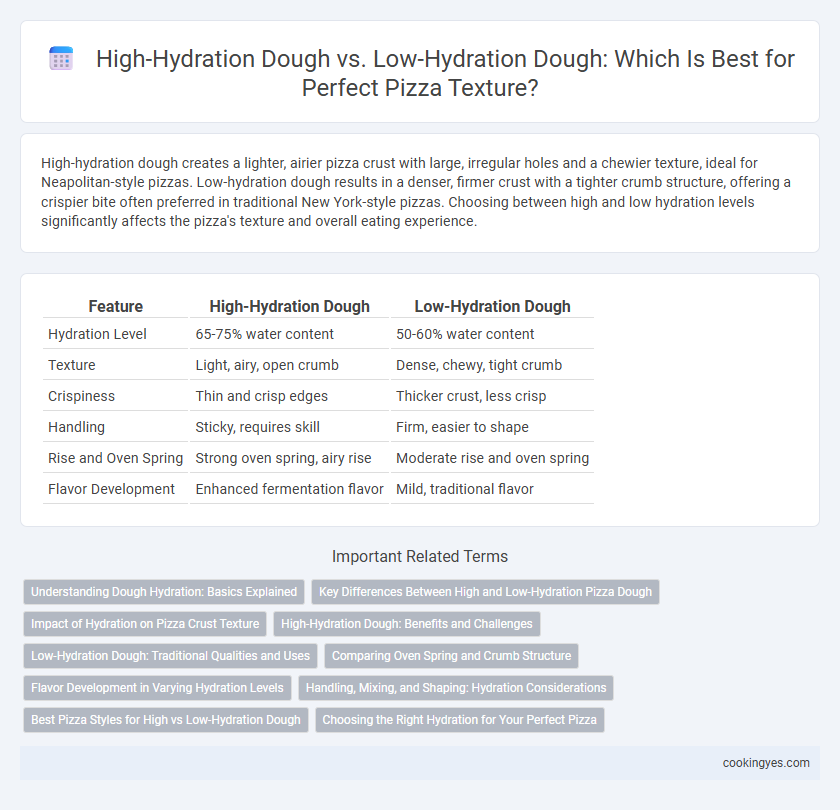High-hydration dough creates a lighter, airier pizza crust with large, irregular holes and a chewier texture, ideal for Neapolitan-style pizzas. Low-hydration dough results in a denser, firmer crust with a tighter crumb structure, offering a crispier bite often preferred in traditional New York-style pizzas. Choosing between high and low hydration levels significantly affects the pizza's texture and overall eating experience.
Table of Comparison
| Feature | High-Hydration Dough | Low-Hydration Dough |
|---|---|---|
| Hydration Level | 65-75% water content | 50-60% water content |
| Texture | Light, airy, open crumb | Dense, chewy, tight crumb |
| Crispiness | Thin and crisp edges | Thicker crust, less crisp |
| Handling | Sticky, requires skill | Firm, easier to shape |
| Rise and Oven Spring | Strong oven spring, airy rise | Moderate rise and oven spring |
| Flavor Development | Enhanced fermentation flavor | Mild, traditional flavor |
Understanding Dough Hydration: Basics Explained
High-hydration dough contains 70% or more water relative to flour weight, resulting in a wetter, stickier dough that produces a lighter, airier crust with large, irregular holes. Low-hydration dough, typically below 60%, offers a firmer, denser texture ideal for thin, crispy pizza bases with a chewy bite. Understanding dough hydration helps bakers control pizza texture, balancing crispiness and softness by adjusting water content during mixing.
Key Differences Between High and Low-Hydration Pizza Dough
High-hydration pizza dough, with water content around 65-75%, produces a lighter, airier crust featuring large, irregular holes and a chewy texture. Low-hydration dough, typically containing 50-60% water, results in a denser, thinner crust with a tighter crumb and crispier finish. The hydration level directly influences gluten development and moisture retention, affecting the pizza's overall texture and baking performance.
Impact of Hydration on Pizza Crust Texture
High-hydration pizza dough, containing 70% or more water relative to flour, produces a crust with an open crumb, lightness, and crisp edges due to increased steam during baking. In contrast, low-hydration doughs around 50-60% water result in denser, chewier crusts with tighter crumb structures and a more substantial bite. The hydration level directly influences gluten development and fermentation, which shapes the final texture and mouthfeel of the pizza crust.
High-Hydration Dough: Benefits and Challenges
High-hydration dough, containing 70% or more water relative to flour weight, creates a lighter, airier pizza crust with larger, irregular holes and a chewy texture favored in Neapolitan and artisan styles. The increased moisture enhances gluten development, resulting in a tender bite and improved oven spring during baking. Challenges include a stickier, more difficult dough to handle requiring skilled stretching and longer fermentation times to achieve optimal rise and flavor complexity.
Low-Hydration Dough: Traditional Qualities and Uses
Low-hydration dough, with a water content typically below 60%, produces a denser and chewier pizza crust, characteristic of traditional Neapolitan and New York-style pizzas. This dough type allows for easier handling and shaping with less stickiness, making it ideal for hand-tossed and thin-crust pizza styles. Bakers often prefer low-hydration dough for its ability to develop a crisp exterior while maintaining a sturdy structure that supports various toppings.
Comparing Oven Spring and Crumb Structure
High-hydration dough, typically containing 70% or more water, promotes a superior oven spring due to increased gas retention and steam generation, resulting in a lighter, airier crumb structure with larger, irregular holes. In contrast, low-hydration doughs around 50-60% yield a denser crumb with smaller, uniform holes and reduced oven spring, producing a chewier texture. The choice between high and low hydration directly influences pizza crust characteristics, balancing softness and chewiness based on hydration levels.
Flavor Development in Varying Hydration Levels
High-hydration pizza dough, typically containing 70% or more water relative to flour weight, encourages enhanced enzymatic activity and fermentation, resulting in more complex flavor profiles characterized by tangy sourness and subtle yeast notes. Low-hydration dough, with around 50-60% water, offers a denser crumb and less fermentation time, producing a milder flavor that emphasizes the dough's wheat undertones. Variations in hydration directly influence gluten network formation and fermentation rates, thereby impacting the depth of flavor development in artisanal pizza crusts.
Handling, Mixing, and Shaping: Hydration Considerations
High-hydration dough, containing 70-80% water, produces a softer, airier crust with open crumb but requires careful handling to prevent stickiness during mixing and shaping. Low-hydration dough, typically 55-60% water, offers more control and easier shaping, resulting in a denser and chewier texture. Proper hydration balance directly influences gluten development, dough elasticity, and the ease of forming pizza bases.
Best Pizza Styles for High vs Low-Hydration Dough
High-hydration dough, typically containing 70% or more water, yields a light, airy crust ideal for Neapolitan and focaccia-style pizzas characterized by large, irregular air pockets and a soft chew. Low-hydration dough, with around 50-60% water content, produces a denser, crispier crust perfect for New York-style and thin-crust pizzas that require a sturdy base for toppings. Choosing the right hydration level directly influences the pizza's texture, affecting chewiness, crust crispness, and overall bite quality.
Choosing the Right Hydration for Your Perfect Pizza
High-hydration dough, typically containing 70% or more water, produces a lighter, airier pizza crust with an open crumb structure and a crispy, chewy texture ideal for Neapolitan-style pizzas. Low-hydration dough, with around 50-60% water, yields a denser, firmer crust that retains its shape well and is perfect for thin, crispy Roman-style pizzas or thick, sturdy Sicilian pies. Selecting the optimal hydration level depends on the desired crust texture, baking method, and pizza style, with fermentation time and flour type also impacting the final dough performance.
High-hydration dough vs low-hydration dough for pizza texture Infographic

 cookingyes.com
cookingyes.com